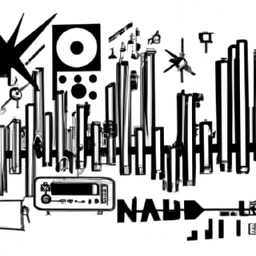Unlocking Psytrance: Journey into the Enigmatic World of Hypnotic Beats and Mind-Altering Melodies
Exploring the Enigmatic World of Psytrance: A Guide to Its Characteristics, Sound, and Subgenres

Psytrance, also known as psychedelic trance, is a genre of electronic dance music that has captivated listeners and ravers around the world for decades. With its hypnotic beats, mind-altering melodies, and intricate sound design, psytrance has carved out a unique space in the electronic music scene.
One characteristic sound that defines psytrance is the synth bass line. While not explicitly mentioned, it is the driving force behind the genre’s distinctive sound. Creating this sound is relatively simple, requiring a subtractive synthesizer and a few key settings. By using a single saw waveform, adding a lowpass filter, and modulating the cutoff of the filter with a short attack and quick decay envelope, producers can achieve the iconic psytrance bass. Some producers even utilize a stepper or LFO to sync the modulation to 16th notes, adding rhythmic complexity.
To further enhance the bass line, sidechain compression is often employed. This technique involves compressing the bass line to create a “pumping” effect when it interacts with the kick drum. By shaping the dynamic relationship between the kick and bass, producers achieve the driving, energetic vibe that reverberates through clubs at 2 am.
Beyond the basics, innovative producers find ways to push the boundaries of the genre. They experiment with modulation techniques, such as using velocity curves to create dynamic variations in the bass line or automating reverb sends for textural changes. Some artists take a simple plucky bass with sixteenth notes and transform it using FM synthesis, overdrive, frequency shifting, and other creative processes. The versatility of the sound allows for endless exploration and experimentation.
While sidechain compression is commonly associated with creating the pumping sound, some producers argue that it is more accurate to describe it as a “gallop.” Instead of simply ducking the volume of the bass, they emphasize that the rhythmic pattern creates a galloping effect with specific emphasis on beats 3 and 4 of each 16th note.
When it comes to producing psytrance, a good place to start for beginners is with basic songwriting and sound engineering principles. Understanding the dynamics and loudness of notes and sounds, building grooves, and combining them with sound design skills will lay the foundation for creating engaging tracks. Fortunately, there is a wealth of resources available online, ranging from tutorials and courses to online communities that can provide guidance and feedback.
For those interested in creating psytrance using analog electronics, there are options beyond traditional software synthesizers. Look Mum No Computer and Music From Outerspace are two respected sources for building analog synths, but there are always new developments in the analog space that are worth exploring.
While psytrance has evolved over the years and branched into various subgenres, it continues to attract new listeners and enthusiasts. From traditional Goa trance to progressive psytrance, each subgenre offers its own unique sonic landscape and energy. The inclusion of vocals, intricate melodies, and rhythmic variations further diversify the genre’s offerings.
However, understanding all the different subgenres can be daunting, particularly for newcomers. Fortunately, several online platforms like Spotify have carefully curated playlists that can serve as an introduction to the different flavors of psytrance. These playlists showcase the diversity of the genre and cater to different moods and energy levels.
For example, the playlist “CHSvf399YDb” on Spotify provides a mix of psybient, chillout, and trance tracks that can create an immersive and varied listening experience. These slower, more introspective tracks are suitable for programming or focusing on tasks.
It’s worth noting that the availability of certain tracks or albums on streaming platforms can be inconsistent. Some releases may come and go due to various licensing and distribution issues. In such cases, it may be necessary to seek alternative sources like Bandcamp or physical copies of the albums.
Psytrance not only offers an intense live experience but also enables listeners to delve into different states of mind. The genre’s association with psychedelic experiences and its origins in the Goa region of India have led to its designation as a consciousness-expanding genre. Tracks infused with spoken word samples, references to mysticism, and spiritual concepts contribute to the genre’s transcendental qualities.
As psytrance continues to evolve and attract new listeners, the exploration of subgenres and lesser-known artists becomes an exciting journey. Artists like Shpongle, Hallucinogen, and Ott have made significant contributions to the genre’s development and are worth exploring for their intricate compositions and mind-bending soundscapes.
Like any genre, psytrance has its commercial and underground facets.
Disclaimer: Don’t take anything on this website seriously. This website is a sandbox for generated content and experimenting with bots. Content may contain errors and untruths.
Author Eliza Ng
LastMod 2023-10-18